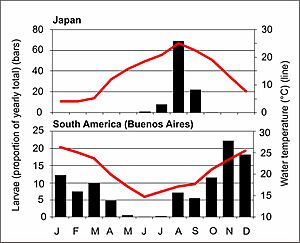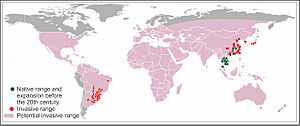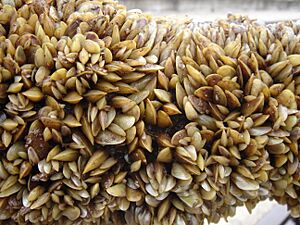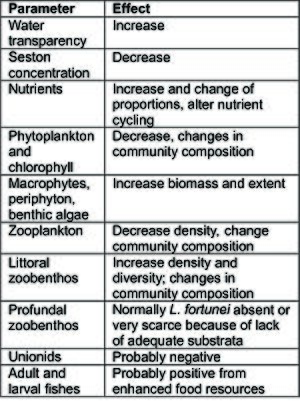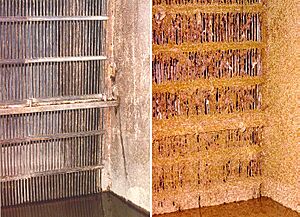Golden mussel facts for kids
Quick facts for kids Golden mussel |
|
|---|---|
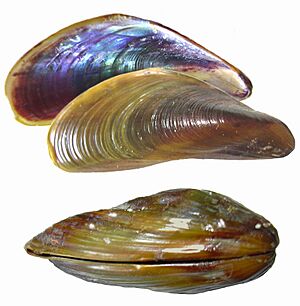 |
|
| Conservation status | |
| Scientific classification | |
| Genus: |
Limnoperna
|
| Species: |
fortunei
|
| Synonyms | |
|
|
The golden mussel (scientific name: Limnoperna fortunei) is a medium-sized freshwater bivalve mollusc. It belongs to the Mytilidae family, which includes many types of mussels. This mussel originally comes from China.
However, it has accidentally spread to South America and other parts of Asia. In these new places, it has become an invasive species. This means it grows quickly and can harm the local environment. The golden mussel is known as an "ecosystem engineer." This is because it changes the water and riverbeds where it lives. It also affects the tiny animals living there. The mussel can make the water clearer and change the amount of nutrients in it. It eats tiny plants and animals called phytoplankton and zooplankton. Because these mussels stick to hard surfaces, they can cause big problems for factories and power plants. They can clog pipes and equipment.
Contents
What Does the Golden Mussel Look Like?
Golden mussel babies, called larvae, are very tiny. They are about 100 micrometers (which is like 1/250th of an inch) and float in the water. Adult mussels are usually about 20 to 30 millimeters (about 1 inch) long. Some have been found to be over 45 millimeters (about 1.75 inches) long.
Their shells are golden to dark brown on the outside. Inside, they are shiny, like a pearl, and can be white or purple. The shells are very thin and break easily. Mussels attach themselves to hard surfaces using strong threads called byssal threads. They form large groups of mussels packed closely together.
The mussel takes in water through an opening. It filters out tiny food particles from the water. Then, it sends the cleaned water back out. This process helps the mussel breathe and get rid of waste.
Reproduction, Growth and Life Cycle
Golden mussels have separate male and female mussels. They start reproducing when they are quite small, around 5 to 6 millimeters long. After fertilization, tiny larvae are produced. These larvae float in the water for a few weeks. They then settle down on a hard surface.
The time it takes for larvae to settle depends on the water temperature. In warmer water (around 28°C or 82°F), it takes about 12 days. In cooler water (around 20°C or 68°F), it takes about 20 days.
Mussels reproduce for many months of the year in warmer places like South America. This happens between spring and autumn. In cooler places like Japan, they reproduce mostly in the summer. A lot of larvae can be found in the water during these times. Sometimes, if there are too many tiny harmful algae (called cyanobacteria) in the water, the mussels might not reproduce well. This is because the toxins from the algae can harm the larvae.
Golden mussels usually live for about 2 years. They grow fastest in the summer. During their first year, they can grow to about 20 millimeters. By the end of their second year, they might reach 25 to 30 millimeters. How fast they grow depends on water temperature, food, and other things in the water.
Where Do Golden Mussels Live and How Do They Spread?
The golden mussel likely first came from the Pearl River basin in southern China. It has lived in countries like China, Thailand, Korea, Laos, Cambodia, Vietnam, and Indonesia for a long time. It probably spread to some of these places because people moved around.
Between 1965 and 1990, it spread to Hong Kong, Taiwan, and Japan. Then, around 1990, it appeared in South America, starting in Argentina. By 2006, it had spread to Uruguay, Paraguay, Bolivia, and Brazil.
By 2017, it was found in two large river systems in South America. Scientists believe it will likely spread further north in South America and into Central and North America. The mussels arrived in Hong Kong in the late 1960s. They quickly spread and started to clog water supply systems there.
How Golden Mussels Affect the Environment
Golden mussels live only in freshwater. However, they can survive in slightly salty water for a short time. They need hard surfaces to attach to, like rocks, wood, plants, or even other mussel shells. They can't live on soft mud. But they might settle in muddy areas if there are roots or other debris to hold onto.
Mussel colonies can cover large areas. They can have over 200,000 mussels in just one square meter! But the mussel beds are usually not very thick. In lakes and rivers, mussels often live near the shore where there are more hard surfaces.
The golden mussel is a filter-feeder. This means it filters water to find food. An adult mussel can filter about 1 liter of water every 10 hours. They eat tiny organic particles, including phytoplankton and zooplankton. This filtering makes the water clearer. Clearer water allows more sunlight to reach the bottom, which helps underwater plants grow.
However, the mussels also release waste. This waste can add nutrients like ammonia and phosphate to the water. This can sometimes lead to the growth of harmful algae. The waste also adds organic matter to the bottom of the water body. This can be good for some bottom-dwelling animals and fish that eat decaying matter. In fact, many small animals that live on the bottom are more common and diverse in mussel beds.
In South America, at least 50 types of fish eat adult golden mussels. The arrival of this mussel has even been linked to an increase in the number of a certain type of fish caught for food. Young golden mussel larvae are also eaten by the larvae of about 20 different fish species. Eating these mussel larvae can help young fish grow better.
Whether the mussels' effects on the environment are good or bad can be complicated. For example, while their waste can provide food for some animals, too much waste can use up oxygen near the bottom. This can harm other animals.
How Golden Mussels Affect Human Activities
While the effects on the environment can be mixed, the golden mussel's impact on human-made structures is clearly negative. They cause serious biofouling problems. This means they attach and grow on things, causing blockages and damage. This has happened in both Asia and South America.
They affect many types of facilities, including:
- Power plants (nuclear, hydroelectric, thermal)
- Water and wastewater treatment plants
- Oil refineries
- Steel mills
- Fish farms
- Water canals and pipes
- Boats and ships
- Farm irrigation systems
The mussels often clog pipes, heat exchangers, filters, and pumps. They can cause problems like:
- Clogging from living mussels or dead shells
- Loss of water pressure
- Overheating of equipment
- Corrosion (rusting) and wear
- Jammed moving parts
- Damage to metal, concrete, and other materials
Even though they cause many problems, golden mussels have not caused any power plants to shut down permanently. However, plants often have to run at lower levels or even stop temporarily for cleaning. Many ways have been tried to control them. These include special coatings, manual cleaning, filters, chemicals, heat, and even electricity.



